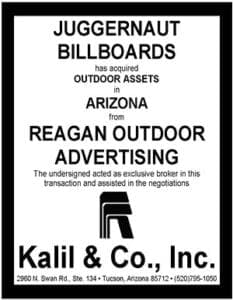 By Steve Nicklin, Vice President of Marketing, OAAA.
By Steve Nicklin, Vice President of Marketing, OAAA.
OOH is poised to record yet another quarter of growth to close out 2016, which will mark the industry’s 27th consecutive quarter of growth. Other than digital media, no other form of media comes anywhere near such a consistent, solid record.
2017 promises a continuation of this trend according to projections by media forecasters recently published by Media Life Magazine.
| Forecaster | 2017 OOH Growth | 2017 Total Ad Spend Growth All Media (incl. digital) |
| Carat | 3.00% | 3.80% |
| GroupM | 3.00% | 2.60% |
| MAGNA | 3.00% | 1.70% |
| ZenithOptimedia | 4.00% | 3.30% |
It is important to note OOH is set to outperform all media, including digital, in three of the four projections. This is especially impressive when considering the growth and size of digital media in today’s environment.
“The outlook for OOH is positive, and better than for most traditional media,“ notes Jonathan Barnard, head forecaster at ZenithOptimedia.
It’s a safe bet OOH’s impressive growth record will continue, but the question remains – at what level?
One determining factor is the overall economy. A strong economy will add more wind to OOH’s sails; conversely, an economic downturn will weaken performance.
The other major factor is continuous improvement in making OOH easier or more attractive to buy.
Digital OOH has provided a significant boon to the industry. What other innovations will help continue the momentum?
One of the most promising innovations is the evolution of OOH measurement. 2017 will bring the introduction of new tools by Geopath, which provides OOH audience measurement. More accurate and real-time data about who is seeing OOH ads will increase the value of OOH with buyers.
“OOH is moving in the right direction,” says Mark Boidman, managing director for media and tech investment banking at Peter J. Solomon Co., of the new measurement tools. “We think this is the channel where, in a fragmenting media landscape, advertisers will want to put dollars.”
Other Forces Driving the Growth of OOH
While digital has primed OOH growth in recent years, there are several other notable trends.
- OOH’s natural convergence with other digital media, which has hurt most other ad forms. OOH complements digital media by amplifying and enhancing it. This phenomenon has brought additional ad revenue to OOH, while most other media have experienced revenue losses as a result of the growth in digital.OOH has benefited from other new technologies, too, such as social media and mobile. Many OOH media campaigns are now picked up on social media, which greatly amplifies the total viewership. When consumers are on mobile devices, OOH is typically one of the last ad forms they’re exposed to just before important path-to-purchase decisions.
- The audience fragmentation occurring with other media has been to OOH’s benefit because of its ubiquitous nature, and the fact it can’t be delayed, skipped or turned off. The declining audiences of other media makes OOH more attractive to advertisers and has led to increased ad spend. While digital does receive the majority of ad dollars leaving most traditional media, Boidman argues that OOH is also getting a healthy share. OOH can add a glam element not easily conveyed by other ad forms.
- OOH has improved due to increased investment and an influx of talent, largely driven by digital across the OOH spectrum (billboards, street furniture, transit, place-based). The innovative opportunities provided by the digital platform have provided the OOH industry with new thinking and new ideas.
- Growing consumer time spent with OOH, which is the exact opposite trend for most ad-based media. “People are spending more time outside their homes,” observes Vincent Letang, executive vice president of global market intelligence at Magna Global. There are record miles being driven on US roadways, record levels of airline passenger travel, and long-term trends for transit usage are very promising. The US continues to become more urban, and that’s where OOH is most heavily concentrated. Mobile devices have provided consumers with new freedoms, and they’re no longer tethered to their homes or offices. They can conduct business anywhere – in restaurants or in coffee shops. But no matter where they go, they’ll be exposed to OOH ads. “The audience keeps increasing,” Letang says.
The foundation for OOH’s increasing audience, and consistent, solid growth is revealed in a number of research studies:
- The USA Touchpoints/RealityMine study, OOH and Today’s Mobile Consumer found consumers spend more time with OOH than any other form of advertising media except TV.
- From 2013-2018, Borrell Associates forecasts OOH will significantly outperform all traditional media in consumer time spent growth. Other than cable TV, all other traditional media are projected to decline.
- The 2016 Nielsen OOH ad study found 91% of US residents age 16 or older, who have traveled in a vehicle in the past month, noticed some form of OOH, and 79% have noticed OOH in the past week. Their research also discovered impressive levels of engagement, with 82% of billboard viewers reporting they look at the advertising message at least some of the time; and over one-third looking at the billboard ad each time or almost each time they noticed one.
- The Nielsen digital billboards study found 71% of digital billboard viewers find them to stand out more than online ads.
Source: Media Life Magazine, Nielsen, Borrell Associates, USA Touchpoints/RealityMine
Paid Ad

















